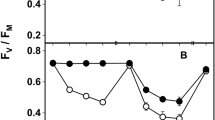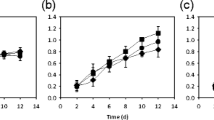Abstract
The aim was to determine which specific regions of the visible light spectrum were responsible for the induction or inhibition of laccase in Pycnoporus sanguineus. Cultures were exposed to various bandwidth lights: blue (460 nm), green (525 nm), white (a combination of 460 and 560 nm), red (660 nm), and darkness. The results indicate that short wavelengths strongly inhibit the production of laccase: green (3.76 ± 1.12 U/L), blue (1.94 ± 0.36 U/L), and white (1.05 ± 0.21 U/L) in proportions of 85.8, 92.6, and 96.0 %, respectively; whereas long wavelengths inhibit laccase production only partially i.e., red light (14.05 ± 4.79 U/L) in a proportion of 46.8 %. Maximum activity was induced in absence of visible light (30 °C, darkness), i.e., 30.76 ± 4.0 U/L. It is concluded that the production of laccase in P. sanguineus responds to light stimuli [measured as wavelengths and lx] and that it does so inversely. This can be explained as an ecological mechanism of environmental recognition, given that P. sanguineus develops inside lignocellulose structures in conditions of darkness. The presence of short wavelength light (460–510 nm) would indicate that the organism finds itself in an external environment, unprovided of lignin, and that it is therefore unnecessary to secrete laccase. This possible new regulation in the laccase production in P. sanguineus has important biotechnological implications, for it would be possible to control the production of laccase using light stimuli.



Similar content being viewed by others
References
Ballario P, Macino G (1997) White collar proteins: PAS sing the light signal in Neurospora crassa. Trends Microbiol 5:458–462
Ballario P, Vittorioso P, Magrelli A, Talora C et al (1996) White collar-1, a central regulator of blue light responses in Neurospora, is a zinc finger protein. EMBO J 15(7):1650–1657
Biezke JA, Braun EL, Bean LE, Kang S et al (1999) The nop-1 gene of Neurospora crassa encodes a seven transmembrane helix retinal-binding protein homologous to archeal rhodopsins. Proc Natl Acad Sci U S A 96:8034–8039
Blumenstein A, Vienken K, Tasler R, Purschwitz J et al (2005) The Aspergillus nidulans phytocrome FphA represses sexual development in red light. Curr Biol 15:1833–1838
Buck JW, Dong W, Mueller DS (2010) Effect of light exposure on in vitro germination and germ tube growth of eight species of rust fungi. Mycologia 102(5):1134–1140
Corrochano LM (2011) Fungal photobiology: a synopsis. IMA Fungus 2:25–28
Criquet S (1999) La litière de chênevert (Quercus ilex L.). Aspects méthodologiques, microorganismes, enzymes et facteurs environnementaux. Paul Cézanne Aix-Marseille III University, Marseille, France
Gyalai-Korpos M, Nagy G, Mareczky Z, Schuster A, Réczey K, Schmoll M (2010) Relevance of the light signaling machinery for cellulase expression in trichoderma reesei (hypocrea jecorina). BMC Res Notes 3:330
Herrera-Estrella A, Horwitz BA (2007) Looking through the eyes of fungi: molecular genetics of photoreception. Mol Microbiol 64:5–15
Jahan MS, Mun SP (2007) Characteristics of dioxanelignins isolated at different ages of Nalita wood (Tremaorientalis). J Wood Chem Technol 27(2):83–98
Janusz G, Kucharzyk KH, Pawlik A, Staszczak M, Paszczynski AJ (2013) Fungal laccase, manganese peroxidase and lignin peroxidase: gene expression and regulation. Enzyme Microb Technol 52:1–12
Janusz G, Mazur A, Checinsks A, Malek W et al (2012) Cloning and characterization of a laccase gene from biotechnologically important basidiomycete Carrena unicolor. J Fac Agr Kyushu U 57:41–49
Jong-Rok J, Yoon-Seok C (2013) Laccase-mediated oxidation of small organics: bifunctional roles for versatile applications. Trends Biotechnol 31(6):335–341
Kunamneni A, Ballesteros A, Plou FJ, Alcalde M (2007) Fungal laccase—a versatile enzyme for biotechnological applications. In: Méndez-Vilas A (ed) Communicating current research and educational topics and trends in applied microbiology. Microbiology series vol 1. Formatex, Badajoz, Spain, pp 233–245
Kyi TS (2011) Screening of potential lignin-degrading microorganisms and evaluating their optimal enzyme producing culture conditions. Master in Science thesis, Chalmers University of Technology, Göteborg, Sweden
Leonowicz A, Grzywnowicz K (1981) Quantitative estimation of laccase forms in some white rot-fungi using syringaldazine as a substrate. Enzym Microb Technol 3(1):55–58
Meng-Juan Z, Fang D, Guo-Qing Z, He-Xiang W, Tzi-Bin N (2013) Purification a laccase exhibiting dye decolorizing ability from an edible mushroom Russula virescens. Int. Biodeterioration Biodegrad 82:33–39
Miller GL (1959) Use of Dinitrosalicylic acid reagent for determination of reducing sugar. Anal Chem 31(3):426–428
Mishra NP, Mishra RK, Singhal GS (1993) Changes in the activities of anti-oxidant enzymes during exposure of intact wheat leaves to strong visible light at different temperatures in the presence of protein synthesis inhibitors. Plant Physiol 102:903–910
Rodríguez-Romero J, Hedtke M, Kastner C, Müller S, Fischer R (2010) Fungi, hidden in soil or up in the air: light makes a difference. Annu Rev Microbiol 64:585–610
Röhrig J, Kastner C, Fischer R (2013) Light inhibits spore germination through phytocrome in Aspergillus nidulans. Curr Genet 59:55–62
Rosales-Saavedra T, Esquivel-Naranjo EU, Casas-Flores S, Martínez-Hernández P et al (2006) Novel light-regulated genes in Trichoderma atroviridae: a dissection by cDNA microarrays. Microbiol 152:3305–3317
Saha A, Mandal P, Dasgupta S, Saha D (2008) Influence of culture media and environmental factors on mycelia growth and sporulation of Lasiodiplodia theobromae (Pat.) Griffon and Maubl. J Environ Biol 29(3):407–410
Schmoll M, Franchi L, Kubicek CP (2005) Envoy, a PAS/LOV domain protein of Hypocreaje corina (Anamorph Trichoderma reesei), modulates cellulase gene transcription in response to light. Eukaryot Cell 4(12):1998–2007
Schmoll M, Tian C, Sun J, Tisch D, Glass NL (2012) Unravelling the molecular basis for light modulated cellulase gene expression—the role of photoreceptors in Neurosporacrassa. BMC Genomics 13:127
StatSoft Inc. (2004) STATISTICA (Data analysis software system). Version 7
Stevenson RE, Pennypacker SP (1988) Effect of radiation, temperature, and moisture on conidial germination of Alternariasolanum. Phytopathology 78(7):926–930
Tisch D, Schmoll M (2010) Light regulation of metabolic pathways in fungi. Appl Microbiol Biotechnol 85:1259–1277. doi:10.1007/s00253-009-2320-1
Velmurugan P, Hoon Y, Kulandaisamy C, Lakshmanaperumalsamy P et al (2010) Effect of light on growth, intracellular and extracellular pigment production by five pigment-producing filamentous fungi in synthetic medium. J Biosci Bioeng 109(4):346–50
Xiao YZ, Hong YZ, Li JF, Hang J et al (2006) Cloning of novel laccase isozyme genes from Trametes sp. AH28-2 analysis of their differential expression. Appl Microbiol Biotechnol 71(4):493–501
Zar JH (1999) Biostatistical Analysis, Prentice Hall (Ed.), New Jersey, EE.UU.
Zhu JC, Wang XJ (2005) Effect of blue light on conidiation development and glucoamylase enhancement in Aspergillus niger. Wei Sheng Wu Xue Bao 45(2):275–8
Acknowledgments
The authors are grateful to the National Council of Science and Technology (Conacyt) of Mexico, for the doctoral scholarship (261027) of Hernández Christian, to the PROMEP program of the National Education Secretary (SEP), and to ECOS-ANUIES-CONACYT Program through the ECOS project M13A02, for financial support. The authors are grateful to Biologist Ramírez-Guillén F., from INECOL A.C., Xalapa, Mexico, for the taxonomical identification of the fungus. The authors are also grateful to the Institute of Biotechnology and Applied Ecology (INBIOTECA), and to the UVCA324 research group from Universidad Veracruzana, Mexico, for facilities support.
Conflict of interest
The authors declare that they have no competing interests.
Author information
Authors and Affiliations
Corresponding author
Rights and permissions
About this article
Cite this article
Hernández, C.A., Perroni, Y., Pérez, J.A.G. et al. Light-induced inhibition of laccase in Pycnoporus sanguineus . Folia Microbiol 61, 137–142 (2016). https://doi.org/10.1007/s12223-015-0418-7
Received:
Accepted:
Published:
Issue Date:
DOI: https://doi.org/10.1007/s12223-015-0418-7




